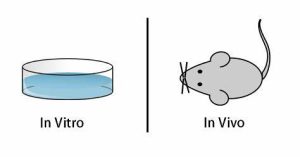In Vivo and In Vitro Techniques
In vivo is Latin for “within the living.” It refers to work that’s performed in a whole, living organism.
In vitro is Latin for “within the glass.” It refers to work that’s performed or happens outside of a living organism.
The main difference between in vitro and in vivo is that in vitro refers to the experimental procedures performed outside a living organism whereas in vivo refers to the experimental procedures performed within a living organism.
In vivo experiments are performed under physiological conditions while in vitro experiments are performed under controlled laboratory conditions.
In vitro, in vivo, or in situ methods are used in scientific studies.
Let’s see In Vivo and In Vitro Techniques in details with some examples.
In vivo
- Experiments are performed using a whole, living organism.
- When a study is performed in vivo, it can include things like performing experiments in an animal model, or in a clinical trial in the case of humans. Here, the work is taking place inside a living organism.
- The overall effect of the experiment on a living organism can be observed in in vivo Thus, in vivo experiments are more precise than in vitro experiments.
- The main objective of in vivo experiments is to gain knowledge about biological systems and/or discover drugs.
- In vivo experiments are more expensive and require more advanced techniques during the experiment.
- Mice, rabbit, and apes are the three main types of living organisms used in in vivo
In vitro
- This technique is used in a laboratory, and can often include things like studying bacteria, animal, or human cells in culture.
- In vitro method is performed in a controlled environment outside of a living organism.
- The majority of cellular experiments are performed in vitro as it is less expensive. But, the regeneration of the physiological conditions of an organism is difficult inside a test tube. Therefore, the results of the in vitro experiments are less precise.
- In vitro experiments are performed using the extracted cellular components (microorganisms, cells, organelles or biological molecules) from their regular biological environments. The cells and microorganisms are grown in artificial culture media while biological molecules are studied in solutions.
- The in vitro experiments are performed in Petri dishes, test tubes or flasks.
Difference Between in vitro and in vivo
Particulars In vitro In vivo Definition It refers to a phenomenon in which a given procedure is performed in a controlled environment outside of a living organism. In vivo refers to a phenomenon in which experiments are performed using a whole, living organism. Sample used Dead organisms or isolated cellular components are used. A whole living organism is used in in vivo experiments. Condition required Condition required Physiological conditions. Experiment time Less time-consuming. More time-consuming. Precision Less precise. More precise. Expenses Less expensive. Expensive. Examples Cell culture experiments in Petri dishes and experiments in test tubes. Drug testing experiments performed by using model organisms such as mice, rabbit, apes etc. Fertilization In vitro fertilization (IVF) refers to the artificial fertilization method in which fusion of male and female gametes occurs outside the human body. It refers to regular fertilization mechanism in which the fusion of male and female gametes occurs within the body.

What is In situ?
In situ means “in its original place.” It lies somewhere between in vivo and in vitro. Something that’s performed in situ means that it’s observed in its natural context, but outside of a living organism.
In situ methods can be used to observe things in their natural context, yet outside of a living organism. A good example of this is a technique called in situ hybridization (ISH).